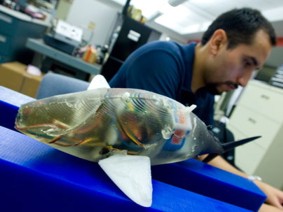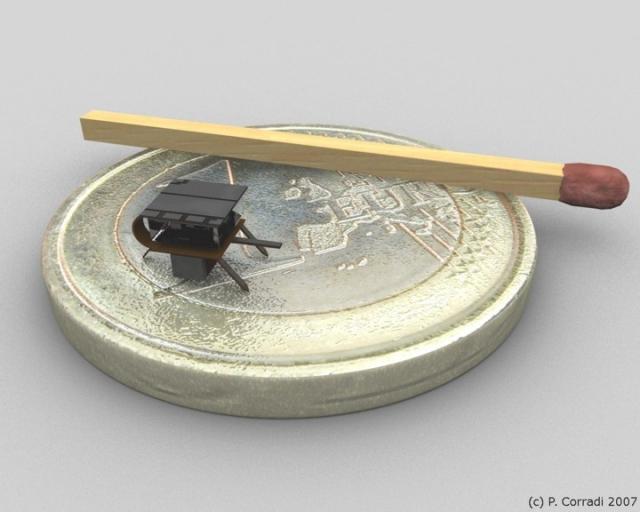Swarms & Schools - There Is Strength In Numbers
While other researchers in this field are focusing on larger, more sophisticated designs, some are showing that smaller and simpler can be better.
I'm talking about MIT's radically simple robotic fish design and Europe's (because many European organizations are involved) I-SWARM. These two robots have two things in common: they're small and simple.
 MIT's robotic fish has only 10 separate components and measures less than a foot in length. For comparison, MIT's older project, Robotuna, was 4-ft long and had 2,843 components controlled by 6 motors. The more recent design is powered by a single motor that sends out a wave starting from the midsection to the robot fish's tail. This action then propels the fish forward. The result is a more fish-like motion.
MIT's robotic fish has only 10 separate components and measures less than a foot in length. For comparison, MIT's older project, Robotuna, was 4-ft long and had 2,843 components controlled by 6 motors. The more recent design is powered by a single motor that sends out a wave starting from the midsection to the robot fish's tail. This action then propels the fish forward. The result is a more fish-like motion.
The I-SWARM is a much smaller robot, measuring only 4 mm on all sides. Just like MIT's fish, the I-SWARM moves by way of vibrations; only this time, the vibrations are propagated by its three tiny legs. If you want a description of its appearance, imagine a three-legged tick.

When deployed individually, these robots can't be very useful. However, en-masse, that should be an entirely different story. Also, even if one, two, or perhaps even ten of them aren't able to make their way back, their loss can be easily absorbed since they usually come much cheaper than their more sophisticated counterparts.
The basic idea here is that, while there are many amazing developments in robotics research, very few make it past the doors of the laboratories where they were created and into production lines. Or if they do get manufactured and sold, many of them (even the record-holders) aren't met with demands proportionate to their supposed potentials - take the world's most dexterous robot hands for example.
Basically, people who invest to integrate these machines into their operations always want to look at the bottom line.
So what are the practical uses of these machines? Although I'm sure you're thinking along the lines of espionage missions, you can add inspection of narrow passages and hard-to-reach spaces. Like, for the robot fish, a school of it can be released to comb a sunken ship for survivors or bodies, oil pipes for leaks, or even corral reefs for signs environmental threats.
On the other hand, swarms of I-SWARMs can be deployed into a (dry) enclosed area. Since they can communicate with one another, those that cannot make direct contact to the outside world can relay their observations to those near it, which in turn can pass it on and so on until the information reaches the desired recipient (a command center, for example). This feature can be useful in landslides, cave-ins, and earthquakes.
- Printer-friendly version
- eigenlance's blog
- Login to post comments
Latest News
Latest Reviews
Latest Blogs
- Navibot SR 8855 wrongly reports battery is already charged so it won't charge at all
- Roomba 531 quite sick
- Neato D7 scratched new hw floors
- Botvac 65 software question
- The Most Promising Companies in Robotics
- error on wi fi indicator
- Caveat Emptor - Neato Connect
- Say no to dust, sweeping robots care for your family
- How to replace the battery in the iRobot Roomba
- To Anyone Else Having "Erratic Behavior" with a Neato
Today's Hottest Deals
-
$399.99$299.99
-
$699.99$599.95


